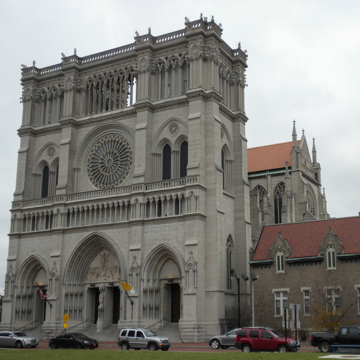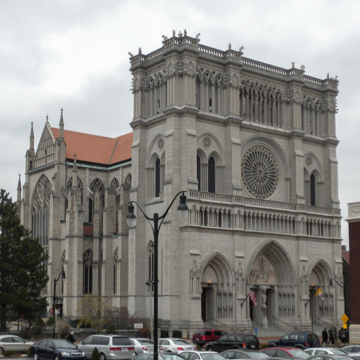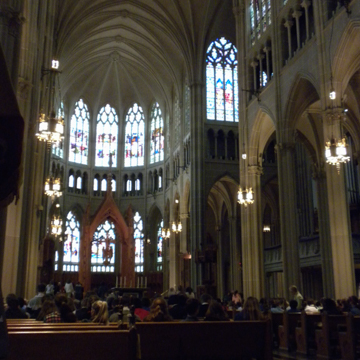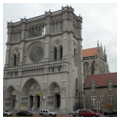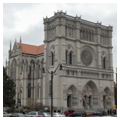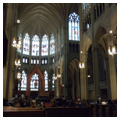The Cathedral of the Assumption is a vivid translation of the French High Gothic. The Most Reverend Camillus Paul Maes, third bishop of Covington, undertook the building of a new cathedral to replace the 1834 frame church that the diocese had outgrown. Covington, Kentucky, which sits directly across the Ohio River from Cincinnati, has been the seat of the diocese since 1853. To accommodate the thriving Catholic community, Maes hired Detroit architect Leon Coquard to build a stone cathedral modeled on twelfth-century French architecture.
Construction began in 1895 but funding ran out before the Cathedral was fully completed, although it was complete enough by 1901 to hold church services. A simple brick wall, rather than an elaborate facade, was constructed to temporarily serve as the western facade. Between 1908 and 1910, local architect Davis D. Davis built the intended facade, which was modeled on that of Notre Dame in Paris, with its robust geometry of three vertical and three horizontal zones punctuated by a massive, centrally placed rose window. Cincinnati sculptor Clement Barnhorn created the sculptures of the trumeau and tympanum. The 26 gargoyles that guard the Cathedral were carved in Italy. Davis planned 52- foot towers for the facade but these remain unbuilt.
The entire building is constructed of Indiana limestone, the clarity and light color of which balances the richly colored stained glass windows that dominate the space. The cathedral measures 194 by 144 feet with a nave height of 81 feet. The compound piers of the nave measure 26 feet high and support a four-bay triforium gallery and tall clerestory. The interior was modeled on that of Saint Denis in Paris. The nave culminates in a load-bearing quadripartite rib vaulted ceiling. The Cathedral’s interior is bathed in the colored light of the 82 stained glass windows, all except four made by the Franz Mayer Studios in Munich, Germany. The transept of great north window measures 67 feet high by 27 feet wide and is said to be the largest ecclesiastical stained glass window in the United States. Rose windows grace the south transept and western facade.
Bishop Maes commissioned Cincinnati native Frank Duveneck to paint a large triptych for the Blessed Sacrament Chapel. In 1946, the interior of the Cathedral was renovated with a verde marble floor and a Carrara marble altar; a baldacchino or canopy of Appalachian oak was also added at this time. The historic Matthias Schwab Organ (1859) was salvaged from the nearby Old St. Joseph Church. Landscape architect John Bentley designed the Cathedral gardens in the early twenty-first century. A 2002 restoration garnered a Preservation Award from the Cincinnati Preservation Association. The Cathedral of the Assumption was elevated to a Minor Basilica in 1953. It is regularly open to the public.
References
Rouse, Mrs. Robert M., “Cathedral Basilica of the Assumption,” Kenton County, Kentucky. National Register of Historic Places Inventory–Nomination Form, 1973. National Park Service, U.S. Department of the Interior, Washington, D.C.












